Evidently there was some great significance in the
manu kake figure. It the G text it had been placed at the beginning of the 3rd glyph line,
where - according to my assumed epoch for rongorongo - the Head of the Giant (Hercules) culminated
(at 24h - 3h) in the night. At the same time as the Full Moon was close to the Goat (Gredi,
α Capricorni), the Sun was at the End (Al Tarf, β
Cancri):
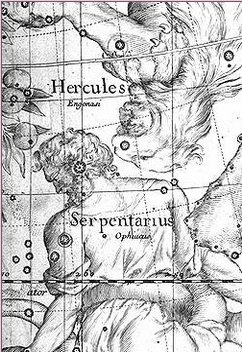
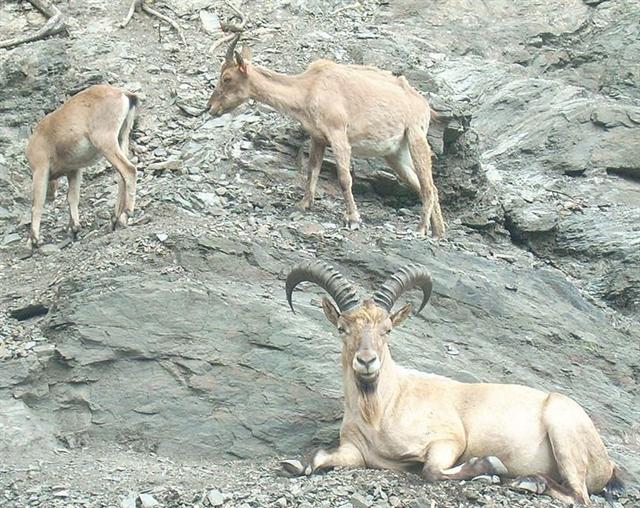
The vertical direction characterizing high summer was in contrast to the
horizontal direction of midwinter:
.jpg)
... They were Ranginui, the Sky
Father, and Papatuanuku, the Earth Mother, both sealed
together in a close embrace. Crushed between the weight of their
bodies were their many children, whose oppression deepened. They
yearned to be free; they fought their parents and each other to
break loose. Tuumatauenga, virile god of war, thrust and
shouted; Tangaroa of the oceans whirled and surged;
Tawhirirangimaatea, Haumiatiketike and Rongomatane,
of wild foods and cultivated crops, tried their best but were
not successful; and Ruamoko, god of earthquakes, yet to
be born, struggled in the confinement of his mother's womb ...
Of them all, Taane Mahuta, the god of the forests, was
the most determined; he set his sturdy feet upon his father's
chest, and braced his upper back and shoulders against the bosom
of his mother. He pushed; and they parted. So the world, as the
Maori understand it, came into being ...
|
he ruru he taiko |
he kumara he kiakia |
he tuvi |
|
Sula cyanops
... It should be pointed out that
the combined name ruru-taiko refers in
MAO. to a black petrel (Procellaria
parkinsoni). There are no cultural data
available for ruru, which seems to be derived
from PPN. *lulu 'owl'...
There are no cultural data available for ...
taiko (compare RAR. taiko 'black petrel',
MGV. tiaku 'petrel?, omen of death', but the
textual association of taiko and spirits
should be dept in mind ...

...
The transference of the name for
sweet potatoes, kumara, to a sea bird (Oestrelata
incerta or Oestrelata leucoptera)
presents a problem in taxonomy. In a short
recitation that accompanies the string game, the
next bird on the list, kiakia, the white
tern, is associated with the leaves of the sweet
potato ...
White tern. Leucanus albus royanus
...
... Grey tern, Tuvituvi (Procelsterna
caerulea skottsbergi)
...
Anous stolidus
unicolor
... The dark
brown tern with a round tail is called tuao
... I was told that tavi is a small,
lead-colored bird that lives on the little islets (motu)
off the coast. He is supposed to look like the
tuvi, the grey tern, and owes his name to his
call ... |
|
MAY 20 (140) |
21 (*61) |
22 |
23 |
24 (144 = 12 *
12) |
 |
 |
 |
 |
 |
|
Ga3-1 |
Ga3-2 |
Ga3-3 |
Ga3-4 |
Ga3-5 (64 = 8 *
8) |
|
AL TARF (The End)
= β Cancri
(124.3)
RAS ALGETHI (α
Herculis)
|
χ Cancri (125.2),
BRIGHT FIRE
= λ Cancri
(125.4)
*84.0 = *125.4 - *41.4 |
AVIOR
= ε Carinae
(126.4), φ Cancri (126.8)
*85.0 = *126.4 - *41.4 |
ο Ursae Majoris
(127.4)
*86.0 = *127.4 - *41.4 |
Pushya-8
(Nourisher)
υ Cancri (128.1),
θ CANCRI
(128.2) |
|
July 23 (204) |
24 (*125) |
25 |
26 (187 + 20) |
27 (208) |
|
°July 19 (200) |
20 (*121) |
21 |
22 / 7 |
23 (204) |
|
26 (177 = 6 * 29½) |
'June 27 |
28 |
29 (*100) |
SIRIUS |
|
"June 12 |
13 (*84) |
14 (165 + 365) |
Te Maro 15 |
16 |
|
Day 365 + 166 = 531 = 18 * 29½ (Te
Maro 15).


 |
|
... Makoi got up and began
to familiarize himself with the (new) land. (This
took place) on the fifteenth day of the month of
June ('Maro'). He went toward the sheer face
of the rocks (titi o te opata), was
astonished (aaa), came up to the middle (of
the outer rim of the crater), and stood at the very
edge. He looked down and saw the 'Pu
Mahore of Hau Maka' (on the coast)
and said, 'There it is, the hole of the mahore
fish of Hau Maka!' He turned his face and
looked toward the back (i.e., in the direction of
the crater). No sooner had he seen how the dark
abyss opened up (below him), when a fragrant breeze
came drifting by. Again Makoi said, 'This is
the dark abyss of Hau Maka'. He turned
around, walked on in utter amazement, and arrived at
the house. He spoke to Ira, 'Hey you, my
friends! How forgetful we (truly) are. This place is
adequate (? tau or 'beautiful'), the dark
abyss lies there peacefully!' Ira replied,
'And what should that remind us of up here?' All
arose and climbed up. They went on and arrived; they
all had a good look (at the inside of the crater).
They returned home and sat down. Night fell, and
they went to sleep ...
[E:19]
 |
|
CLOSE TO THE FULL
MOON: |
|
NOV 19 (*243) |
20 (324) |
21 |
22 |
23 |
|
GREDI (Goat)
=
α
Capricorni
(307.2),
σ
Capricorni (307.5),
ALSHAT (The Sheep)
=
ν
Capricorni
(307.9) |
Al Sa’d al Dhabih-20 (Lucky One of the Slaughterers)
/
Ox / Herd Boy-9
(Buffalo)
DABIH
=
β
Capricorni
(308.0),
κ
Sagittarii (308.1),
SADIR (Hen's Breast)
=
γ
Cygni
(308.4),
PEACOCK
=
α
Pavonis
(308.7)
*267.0
= *308.4 - *41.4 |
OKUL = π Capricorni
(309.6),
BOS = ρ Capricorni
(309.9)
ARNEB (α Leporis)
MINTAKA (δ Orionis)
|
ο
Capricorni (310.2),
θ
Cephei (310.5)
HEKA (λ Orionis)
ALNILAM (ε Orionis)
|
ROTTEN
MELON
= ε Delphini,
φ Pavonis (311.2), η Delphini (311.4), ζ Delphini, ρ
Pavonis (311.7)
PHAKT (α Columbae)
ALNILAK (ζ Orionis)
|

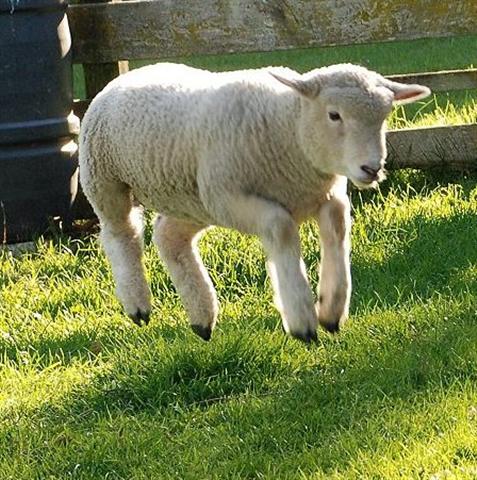 |
|
Jan 22 |
23 (388) |
24 |
25 (*310) |
26 |
|
°Jan 18 (383) |
19 |
20 |
21 (*306) |
22 |
|
'Dec 27 (360) |
28 |
29 |
30 |
31 (*284) |
|
"Dec 12 (*266) |
13 |
14 (348) |
14 |
16 |
When Makoi began to familiarize himself with the new
land - where he would stay behind when the rest of the Explorers
sailed home - this happened 3 days later in "June 15 (166 = 531 -
365), when the Sun reached the right ascension line at the Nose
(the Front) of Ursa Major:

|
Egyptian eye |
 |
Phoenician ayin |
 |
Greek omicron |
Ο
(ο) |
|
... The letter name is derived from
Proto-Semitic
*‘ayn-,
eye, and the Phoenician letter had an eye-shape,
ultimately derived from the jr hieroglyph ... To
this day,
‘ayin in Hebrew, Arabic and Maltese
means 'eye' and 'spring' (‘ayno
in Neo-Aramaic). |
|
Egyptian
nfr |
 |
Phoenician
teth |
 |
Greek
theta |
Θ (θ) |
|
... The form of the letter
θ suggests a midline
('waist'), although the origin of θ is the
Phoenician tēth which means 'wheel'. This in
turn could have originated from a glyph named 'good'
which in Egypt was nfr ...
... θ
is the last star in the Ara constellation, and the
ancient meaning of this letter was described as a
wheel by the Phoenicians but for the Egyptian it
meant 'good'. When the wheel of time has come
full cycle around and the upside down fire-altar is
in the past the times ahead should be good (or lucky
Sa'ad) ...
According to Wilkinson nefer
originally depicted the throat and heart of a sheep:

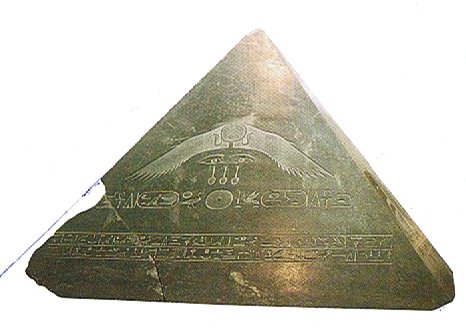 |
Vega |
Alphekka Meridiana |
|
ο Ursae Majoris
(*127) |
θ Cancri
(*128) |
|
Polaris (*26) |
Sheratan
(*27) |
|
Dramasa
(*320) |
α Octantis
(*321) |
We should look for the corresponding heliacal stars in day
166 - 16 = 150, i.e. the stars which returned to visibility in "June
15:
|
"June 15 (166) |
72 |
"Aug
27 (239) |
5 |
"Sept
2 (245) |
42 |
"Oct
15 (288) |
|
166 - 16 = 150 |
239 -
16 = 223 |
245 -
16 = 229 |
288 -
16 = 272 |
|
May 30 (150) |
Aug
12 (223) |
Aug
17 (229) |
Sept
29 (272) |
But in May 30 (80 + 70 = 150) the right
ascension day *70 seems to have had no star of
importance. The reason (for why the created
cosmos had no such star) could have been that 350 / 5
= 70 = 420 / 6.
no star listed (70)
(3112 BC + AD 1842) * 365.25 / 26000 =
70 →
10 weeks
Which in turn might have determined the Mayan day
for the creation of our present world. At the
origin nothing could yet be seen - neither Sun,
the Moon, nor the stars.
... Long ago in the very
beginning of time there dwelt within a shell an
infant god whose name was Ta'aroa. He was
Ta'aroa the unique one, the ancestor of
all gods, the creator of the universe whose
natures were myriad, whose backbone was the
ridgepole of the world, whose ribs were its
supporters. The shell was called Rumia,
Upset. Becoming aware at last of his own
existence and oppressed by a yearning loneliness
Ta'aroa broke open his shell and, looking
out, beheld the black limitless expanse of empty
space. Hopefully, he shouted, but no voice
answered him. He was alone in the vast cosmos.
Within the broken Rumia he grew a new
shell to shut out the primeval void ...
The Full Moon was at Atria
(α Triangulum Australe).
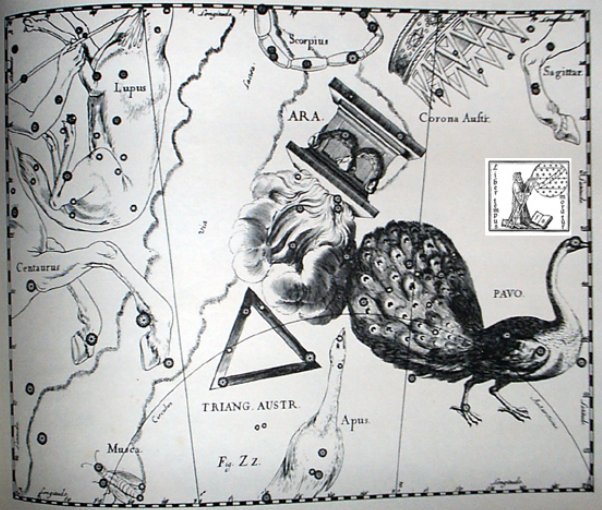
|
... In three
magnificent texts at the site of
Koba, scribes recorded it as one
of the largest finite numbers we
humans have ever written. According
to these inscriptions, our world was
created on the day 4 Ahaw 8
Kumk'u. On this day all the
cycles of the Maya calendar above
twenty years were set at thirteen -
that is to say, the cycles of 400
years, 8,000 years, 160,000 years,
32,000,000 years, and so on, all the
way up to a cycle number extending
to twenty places (2021 *
1360-day year).
In our calendar, this
day fell on August 13, 3114 BC. To
understand what this means, we need
a little scale. The thirteens in
this huge number act like the twelve
in our cycles - the next hour after
twelve is one. Thirteen changed to
one as each of these cycles in the
Maya calendar was completed,
therefore, we have the following
sequence:
|
13. |
13. |
13. |
0. |
0. |
0. |
1. |
5 Imix |
9 Kumk'u |
(Aug. 14,
3114 B.C.) |
|
13. |
13. |
13. |
0. |
0. |
1. |
0. |
11 Ahaw |
3 Pop |
(Sept. 2,
3114 B.C.) |
|
13. |
13. |
13. |
0. |
1. |
0. |
0. |
13 Ahaw |
3 Kumk'u |
(Aug.7,
3113 B.C.) |
|
13. |
13. |
13. |
1. |
0. |
0. |
0. |
2 Ahaw |
8 Mak |
(May 1,
3094 B.C.) |
|
13. |
13. |
1. |
0. |
0. |
0. |
0. |
3 Ahaw |
13 Ch'en |
(Nov. 15,
2720 B.C.) |
|
13. |
13. |
13. |
0. |
0. |
0. |
0. |
4 Ahaw |
3
K'ank'in |
(Dec. 23,
A.D. 2012) |
|
13. |
1. |
0. |
0. |
0. |
0. |
0. |
10 Ahaw |
13
Yaxk'in |
(Oct. 15,
A.D. 4772) |
|
1. |
0. |
0. |
0. |
0. |
0. |
0. |
7 Ahaw |
3 Zotz' |
(Nov. 22,
A.D. 154587) |
|
|
Itzam-Yeh defeated |
28 May (148), 3149 BC |
|
1st 3-stone place |
21 May (141), 3114 BC |
|
Creation of our
present world |
13 August (225), 3114
BC |
|
Och ta chan
(Hun-Nal-Ye 'entered or became the
sky') |
5 February (36), 3112
BC |
|
21 May, 3114 BC - 5
February, 3112 BC = 542 |
|
542 'happens to be'
the sum of 365 days and 6 * 29½
nights. |
|

... This pot depicts one of the Hero
Twins (One-Ahaw in the Classic texts
and One-Hunaphu in the K'iche' Popol
Vuh) and a great bird who is trying
to land in a huge ceiba tree heavy
with fruit. This mythical bird is
Itzam-Yeh, Classic prototype of
Wuqub-Kaqix, 'Seven-Macaw',
of Popol Vuh fame. In that story, in
the time before the sky was lifted
up to make room for the light, the
vainglorious Seven-Macaw imagined
himself to be the sun. Offended by
his pride, the Hero Twins humbled
him by breaking his beautiful
shining tooth with a pellet from
their blowgun. This pot shows
One-Ahaw aiming at the bird as he
swoops down to land in his tree. As
Itzam-Yeh lands on his perch,
the text tells us he is 'entering or
becoming the sky'.
This particular 'sky-entering' is not
the one mentioned in the Palenque
text. It is the final event that
occurred in the previous creation
before the universe was remade.
Before the sky could be raised and
the real sun revealed in all its
splendor, the Hero Twins had to put
the false sun, Itzam-Yeh, in
his place. If the date on this pot
corresponds to that pre-Columbian
event, as we believe it does, then
Itzam-Yeh was defeated on
12.18.4.5.0.1 Ahaw 3
K'ank'in (May 28, 3149 B.C.).
After the new universe was finally
brought into existence, First Father
also entered the sky by landing in
the tree, just as Itzam-Yeh
did ... |
Itzam-Yeh was a name for Ursa Major.
|
- |
origo |
1 he koro tea. |
2 he hihi. |
3 he pukapuka. |
|
Koro. 1. Father (seems to be an
older word than matu'a tamâroa). 2. Feast,
festival; this is the generic term for feasts featuring
songs and banquetting; koro hakaopo, feast where
men and women danced. 3. When (also: ana koro);
ana koro oho au ki Anakena, when I go to Anakena;
in case, koro haga e îa, in case he wants
it. Vanaga. If. Korokoro, To clack the tongue (kurukuru).
Churchill. Ma.: aokoro, pukoro, a halo
around the moon. Vi.: virikoro, a circle around
the moon. There is a complete accord from Efaté through
Viti to Polynesia in the main use of this stem and in
the particular use which is set to itself apart. In
Efaté koro answers equally well for fence and for
halo. In the marked advance which characterizes social
life in Viti and among the Maori the need has been felt
of qualifying koro in some distinctive manner
when its reference is celestial. In Viti virimbai
has the meaning of putting up a fence (mbai
fence); viri does not appear independently in
this use, but it is undoubtedly homogenetic with Samoan
vili, which has a basic meaning of going around;
virikoro then signifies the
ring-fence-that-goes-around, sc. the moon. In the Maori,
aokoro is the cloud-fence. Churchill 2. |
|
MARCH 20 (*364) |
0h |
22 (*1) |
23 |
24 (83) |
 |
no glyph |
 |
 |
 |
|
Gb8-30 (242) |
Ga1-1 |
Ga1-2 |
Ga1-3 |
|
Al Dabarān-2 (The Follower)
HYADUM I
= γ Tauri
(63.4)
*22.0 =
*63.4 - *41.4 |
HYADUM II
= δ¹ Tauri
(64.2) |
Net-19 (Crow)
AIN
(Eye) =
ε Tauri,
θ¹
Tauri,
θ²
Tauri (65.7) |
no star listed (66) |
no star listed (67) |
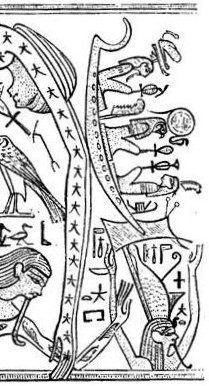
... There was no
water in the village. The lakes and rivers were dry.
Raven and Crow, two young girls who were having their
first menstrual courses, were told to go and draw water
from the ocean. Finding the journey too long, Raven
decided just to urinate into her basket-bucket. She
decieved no one and was severly scolded. Crow returned
much later but with drinking water. As a punishment,
Raven was condemned never to find water in the summer;
only in winter would she find something to drink. For
that reason the Raven never drinks during the hot
months; she speaks with a raucous voice because of her
dry throat
... |
|
May 23 |
24 |
25
(145) |
26 (*66) |
27 |
|
°May 19 |
20 |
21 (*61) |
22 (142) |
23 |
|
'April 26 |
27 |
28 (118) |
29 (*39) |
30 |
|
"April 12 |
13 |
14 (104) |
15 (*25) |
16 (471 = 314 * 1½) |
|
CLOSE TO THE FULL
MOON: |
|
SEPT 19 |
20 (*183) |
21 (264) |
EQUINOX |
23 |
|
YED POSTERIOR (Hand Behind)
=
ε
Ophiuchi,
RUKBALGETHI SHEMALI
(Northern Knee of the Giant) =
τ
Herculis
(246.6).
δ
Apodis (246.7),
ο
Scorpii (246.8) |
Heart-5 (Fox)
σ
Scorpii
(247.0),
HEJIAN = γ Herculis
(247.2),
ψ
Ophiuchi (247.7) |
ρ
Ophiuchi (248.1),
KAJAM
(Club)
=
ω
Herculis
(248.3),
χ
Ophiuchi (248.5),
SHE LOW (Market Tower) = υ Ophiuchi,
Tr.
Austr. (248.7), ζ Tr. Austr. (248.8) |
Al
Kalb-16 (The Heart) /
Jyeshtha-18 (Eldest) /
ANA-MUA-1 (Entrance pillar)
ANTARES
= α Scorpii
(249.1),
MARFIK (Elbow) = λ Ophiuchi,
φ Ophiuchi (249.5), ω Ophiuchi (249.8) |
γ Apodis (250.1), σ Herculis (250.3), θ Tr. Austr.
(250.6), τ Scorpii (250.7) |
|
... Proclus informs
us that the fox star nibbles continuously at the thong
of the yoke which holds together heaven and earth;
German folklore adds that when the fox succeeds, the
world will come to its end. This fox star is no other
than Alcor, the small star g near zeta Ursae
Majoris (in India Arundati, the common wife of
the Seven Rishis, alpha-eta Ursae
...
 |
|
Nov 22 |
23 (327) |
24 |
25
(*249) |
26 |
|
°Nov 18 |
19 |
20 (*244) |
21 (325) |
22 |
|
'Oct 26 |
27 (300) |
28 |
29 (*222) |
30 |
|
"Oct 12 |
13 (286) |
14 |
15 (*208) |
16 |
 |
|
4 he pia. |
5 he nahoo. |
1
he ngeti uri. |
|
Naholoholo
('Swift-running') |
|
MARCH 25 (84) |
26 (*5) |
27 |
 |
 |
 |
|
Ga1-4 |
Ga1-5 |
Ga1-6 |
|
Rohini-4 (The Red One) /
Pidnu-sha-Shame-4 (Furrow of Heaven)
/
ANA-MURI-2 (Rear pillar - at the foot of which was
the place for tattooing)
ALDEBARAN
= α Tauri
(68.2),
THEEMIN = υ² Eridani
(68.5) |
no star listed
(69) |
no star listed (70)
(3112 BC + AD 1842) * 365.25 / 26000 = 70 |

On
Tahiti Aldebaran was named Ana-muri (star
pillar at the end - presumably of summer) and as a
further clue it was stated that here (when the Sun
reached the 'foot' of Aldebaran) was the place for
tattooing → darkening as observed from a place south
of the equator. Rigel ('Foot') was at the foot of
Orion (as perceived from a place in the north), i.e.
we can interpret 'foot' as corresponding to time
zero (origo) - where Land (to walk on) in the sky
dome had arrived. Here time was moving quickly (naholoholo)
in contrast to at the solstices.
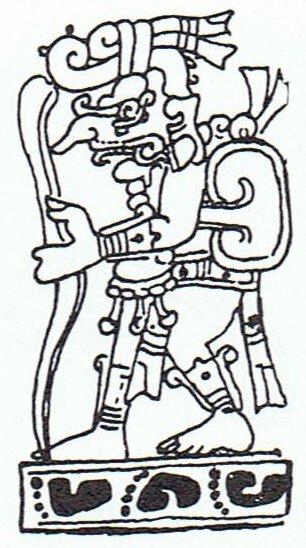 |
|
Itzam-Yeh defeated |
May 29 (88 + 61) |
30 (*70) |
|
°May 24 (144) |
25 (*65) |
26 |
|
'May 1 (121) |
2 (*42) |
3 |
|
"April 17 (107) |
18 (*28) |
19 |
|
CLOSE TO THE FULL
MOON: |
|
SEPT 24 (84 +
183) |
25 (*188) |
26 |
|
HAN = ζ
Ophiuchi
(251.0) |
ζ
Herculis,
η
Tr. Austr.
(252.1), η Herculis, β Apodis (252.5) |
ATRIA
=
α
Tr. Austr.
(253.9) |
|
Manacle |
ziqq |
Phoenician zayin |
 |
Greek
zeta |
Ζ (ζ) |
|
...
Zeta (uppercase Ζ,
lowercase ζ;
Greek: ζήτα
... is the sixth letter of the Greek
alphabet. In the system of Greek
numerals, it has a value of 7. It was
derived from the Phoenician letter
Zayin. Letters that arose from zeta
include the Roman Z and Cyrillic
З ...
Zayin
(also spelled Zain or Zayn
or simply Zay) is the seventh
letter of many Semitic abjads ... It
represents the sound
[z]. The Phoenician letter
appears to be named after a sword or
other weapon. (In Biblical Hebrew, 'Zayin'
means sword, and the verb 'Lezayen'
means to arm. In modern Hebrew, 'zayin'
means penis and 'lezayen' is a
vulgar term which generally means to
perform sexual intercourse and is used
in a similar fashion to the English word
fuck, although the older meaning
survives in 'maavak mezuyan'
(armed struggle) and 'beton
mezuyan' (armed, i.e., reinforced
concrete). The Proto-Sinaitic glyph
according to Brian Colless may have been
called ziqq, based on a
hieroglyph depicting a 'manacle'.
... The shaman climbing the 'stairs' or
notches of his post or tree, pretending
that his soul ascends at the same time
to the highest sky, does the very same
thing as the Mesopotamian priest did
when mounting to the top of his
seven-storied pyramid, the ziqqurat,
representing the planetary spheres ... |
|
|
Nov 27 |
28 |
29 (333) |
|
°Nov 23 |
24 (*248) |
25 (329) |
|
'Oct 31 (*225) |
'Nov 1 |
2 (306) |
|
"Oct 17 (*210) |
18 |
19 (292) |
 |
... the Hawaiian staple, taro, is
the older brother of mankind, as indeed all useful plants
and animals are immanent forms of the divine ancestors - so
many kino lau or 'myriad bodies' of the gods.
Moreover, to make root crops accessible to man by cooking is
precisely to destroy what is divine in them: their
autonomous power, in the raw state, to reproduce ...
|
10 + 2 variants of taro brought
by Oti from the plantation of Teke:
|
|
1 |
*70 |
ngeti uri. |
a Teke. a Oti. |
|
2 |
*71 |
ngeti tea. |
|
3 |
*72 |
he ngaatu. |
|
4 |
*73 |
he tuitui koviro. |
|
5 |
*74 |
he ketu anga mea. |
|
6 |
*75 |
he ketu takarua. |
|
7 |
*76 |
he teatea. |
|
8 |
*77 |
he ngu haha tea. |
|
9 |
*78 |
he mango. |
|
10 |
*79 |
he hahara rapanui |
|
1 |
*80 |
he ti. |
|
1 |
*81 |
he kape. |
|
... And then
followed 5 varieties of banana (maika)
and 12 varieties of taro [E:67-68]: ... (There
were) five hundred baskets of banana shoots, a
thousand baskets of taro, fifty bundles of long
ti roots, and ten baskets of little kape
seedlings ... |
|
Taro.
Taro (Colocasia
esculenta). Some varieties are: taro
harahara hiva, taro teatea, taro vai ho iti,
taro pia, taro tui ko vero, taro ketu aga mea,
taro gaatu apó, taro guhu haha tea, taro magó,
taro ketu takarua, taro ketu tuvítuví, taro
vaihí, taro harahara rapanui, taro horehore
tapatea, taro kape. Vanaga. Caladium
esculentum T. P Mgv., Ta.: taro, id.
Mq.: taó, id. Churchill. |
To reproduce was the theme from Midsummer, to generate
offspring.

... The Mnajdra Temple is located on Malta
and very ancient, dating to the time before the
pyramids. Marija Gimbutas: 'To sleep within the
Goddess's womb was to die and to come to life anew'. In
a system of reincarnation the old one must die in order
to be reborn, of course. At midsummer Sun comes to a
standstill,
and this must therefore be an occasion when the 'flame
of life' had to be transported into a new body ...
Makoi.
The tree which on T. was called
miro, Thespesia populnea. Van Tilburg.
Makoikoi, kidney T. Churchill.
After Makoi had returned they slept in
Te Pou in "July 10 and then they all went straight ahead
to
Hua Reva:
...
Makoi replied, 'In Hiva the land belongs to him - the
land here is mine, not his [tae oona]!'
They stayed (there longer). On the fifth day of the
month of July (Anakena), they all got up, went
downhill, went on, and reached Hanga Te Pau. They
took their provisions with them, carrying them on their
shoulders, went on, and reached Te Pou. They made
camp and slept in Te Pou on the tenth of the
month of July (Anakena). Then they all got up,
carried their provision on their shoulders, went
straight ahead, and followed the path of the dream soul
of Hau Maka. They came to Hua Reva and
said, This is Hua Reva A Hau Maka!...
[E:21-22]
|
Te Maro 15 |
24 |
Te Anakena 10 |
47 |
|
5 |
Hora Nui 2 |
42 |
Tangaroa Uri 15 |
|
"June 15 (166) |
"July 10 (191) |
"Aug 27 (239) |
"Sept 2 (245) |
"Oct 15 (288) |
|
166 - 16 = 150 |
191 - 16 = 175 |
239 - 16 = 223 |
245 - 16 = 229 |
288 - 16 = 272 |
|
150 - 41 = 109 |
175 - 41 = 134 |
223 - 41 = 182 |
229 - 41 = 188 |
272 - 41 = 231 |
|
109 - 39 = *70 |
134 - 39 = *95 |
182 - 39 = *143 |
188 - 39 = *149 |
231 - 39 = *192 |
|
May 30 (150) |
ST JOHN'S DAY |
Aug 12 (223) |
Aug 17 (229) |
Sept 29 (272) |
|
no star listed (*70) |
CANOPUS (*95) |
ALTERF (*143) |
(*149) |
MIMOSA (*192) |
|
ATRIA (*253) |
X-MAS EVE |
(*325) |
(*332) |
DENEB KAITOS
(*9) |
|
→
DARK ABYSS |
→ HUA REVA |
|
→
[E:74] |
→ [E:75] |
|
123 (= 3 * 41) |
Hua. 1. Testicle. 2. Figuratively: son, hua
tahi, only son; fruits of the earth; to grow well
(of fruits). 3. To cause a fight, a quarrel. Hua-ai,
generation, as lineage of direct descendents;
contemporaries. Huahua, coccyx of bird, 'parson's nose':
huahua moa, huahua uha. Huataru, a
creeper (Chenopodium ambiguum). Vanaga. 1.
The same; ki hua, again, to continue, to strain,
to struggle, to move, to repeat, over and above. Mq.:
hua, the same, to return, to recommence. 2. To
bloom, to sprout; flower, fruit (huaa); huaa
tae oko, huaa vahio, young fruit; hua atahi,
only son; huahaga, fruit; mei te huahaga o
tokoe kopu, the fruit of thy body; tikea huahaga,
deceptive appearance. P Pau.: ua, to be born;
huahaga, lineage. Mgv.: hua, to produce (said
of trees, grain, etc.), blooming time of flowers,
abundance of fruit. Mq.: hua, to produce, to bear
fruit. Ta.: ua, to sprout. Huahua. 1.
Tailless fowl. 2. Vein, tendon, line. 3. Mgv.: huahua,
pimples covering the face. Ta.: huahua, id. Mq.:
hua, tubercules. Sa.: fuafua, abscess on
hand or feet. Ma.: huahua, small pimples. Pau.:
Hua-gakau, rupture. Ta.: áau, entrails.
Sa.: ga'au, id. Ma.: ngakau, id.
Churchill. 1. Fruit. 2. Egg. 3. Tā
hua = 'genealogical writing' or 'same writing'.
Fischer.
And to avoid
overcrowding some had to go.
... When the man, Ulu [Uru],
returned to his wife from his visit
to the temple at Puueo, he said, 'I have heard
the voice of the noble Mo'o [Moko],
and he has told me that tonight, as
soon as darkness draws over the sea and the fires of the
volcano goddess, Pele, light the clouds over the
crater of Mount
Kilauea, the black cloth will cover my head. And
when the breath has gone from my body and my spirit has
departed to the realms of the dead, you are to bury my
head carefully near our spring of running water.
Plant my heart and entrails near the
door of the house. My feet, legs, and arms, hide in the
same manner. Then lie down upon the couch where the two
of us have reposed so often, listen carefully throughout
the night, and do not go forth before the sun has
reddened the morning sky.
If, in the silence of the night, you
should hear noises as of falling leaves and flowers, and
afterward as of heavy fruit dropping to the ground, you
will know that my prayer has been granted: the life of
our little boy will be saved.' And having said that,
Ulu fell on his face and died.
His wife sang a dirge
of lament, but did precisely as she was told, and in the
morning she found her house surrounded by a perfect
thicket of vegetation. 'Before the door,' we are told in
Thomas Thrum's rendition of the legend, 'on the very
spot where she had buried her husband's heart, there
grew a stately tree covered over with broad, green
leaves dripping with dew and shining in the early
sunlight, while on the grass lay the ripe, round fruit,
where it had fallen from the branches above.
And this tree she called Ulu
(breadfruit) in honor of her husband. The little spring
was concealed by a succulent growth of strange plants,
bearing gigantic leaves and pendant clusters of long
yellow fruit, which she named bananas.
The intervening space was filled with
a luxuriant growth of slender stems and twining vines,
of which she called the former sugar-cane and the latter
yams; while all around the house were growing little
shrubs and esculent roots, to each one of which she gave
an appropriate name.
Then summoning her little boy, she
bade him gather the breadfruit and bananas, and,
reserving the largest and best for the gods, roasted the
remainder in the hot coals, telling him that in the
future this should be his food. With the first mouthful,
health returned to the body of the child, and from that
time he grew in strength and stature until he attained
to the fullness of perfect manhood.
He became a mighty warrior in those days, and was known
throughout all the island, so that when he died, his
name, Mokuola
[Motu-ora], was
given to the islet in the bay of Hilo [Hiro]
where his bones were buried; by which name it is called
even to the present time ...

... It happens that we know the Norse
name of Gwydion's horse, if Gwydion was indeed Woden, or
Odin. It was Askr Yggr-drasill, or Ygdrasill,
'the ash-tree that is the horse of Yggr', Yggr being one
of Woden's titles. Ygdrasill was the enchanted ash,
sacred to Woden, whose roots and branches in
Scandinavian mythology extended through the Universe
...
In the South
American overview we can see the upside down Hercules
high up in the corner at left - after Corona Borealis:

... In other words, the ancient
Druidic religion based on the oak-cult will be swept
away by Christianity and the door - the god Llyr - will
languish forgotten in the Castle of Arianrhod, the
Corona Borealis. This helps us to understand the
relationship at Rome of Janus and the White Goddess
Cardea who is ... the Goddess of Hinges who came to Rome
from Alba Longa. She was the hinge on which the year
swung - the ancient Latin, not the Etruscan year - and
her importance as such is recorded in the Latin
adjective cardinalis - as we say in English 'of
cardinal importance - which was also applied to the four
main winds; for winds were considered as under the sole
direction of the Great Goddess until Classical times
...
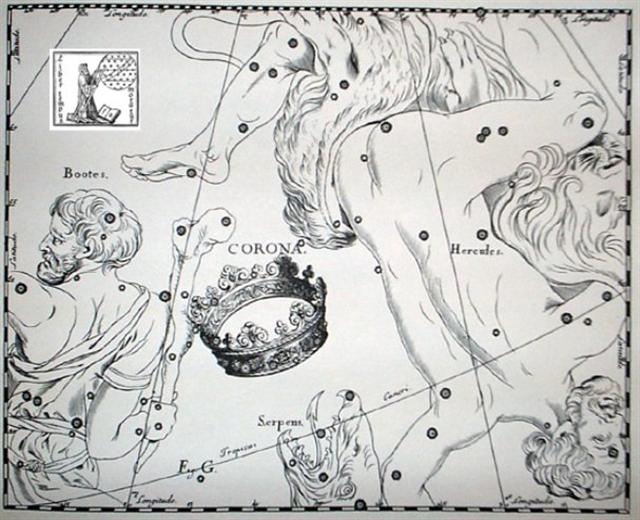
The Serpent was divided at Ophiuchus:
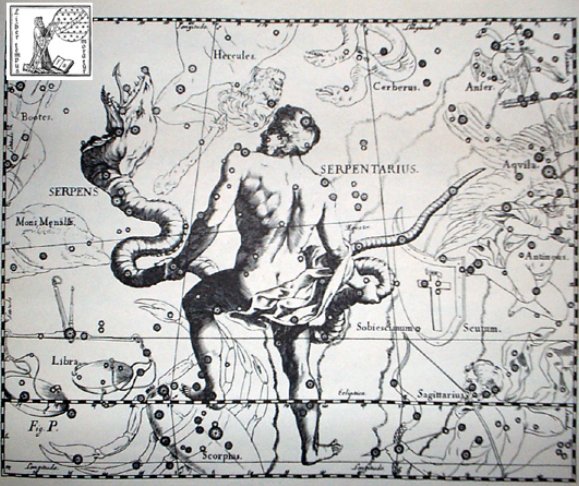

|


.jpg)




























